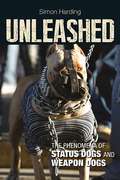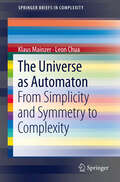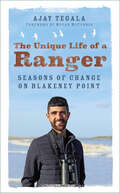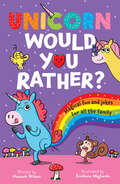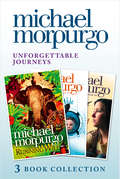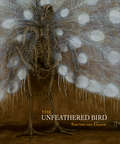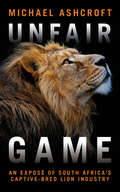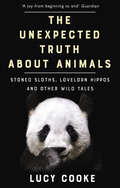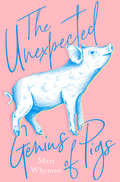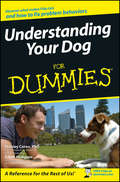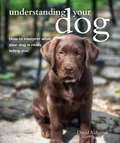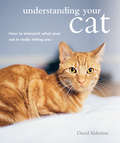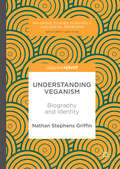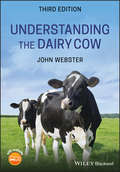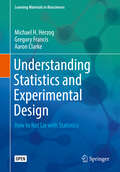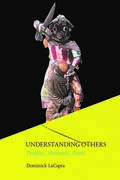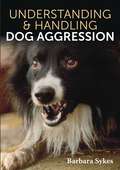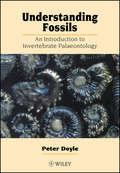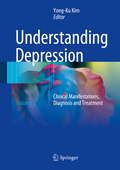- Table View
- List View
Unleashed: The Phenomena Of Status Dogs And Weapon Dogs (PDF)
by Simon HardingDrawing on evidence from both sides of the Atlantic, Simon Harding explores the culture of the status dog in Unleashed. In housing projects in the United States and United Kingdom, certain dog breeds convey status--authority, respect, power, and control--on their owners, while urban street gangs have developed the dangerous practice of training dogs to be weapons. Combining perspectives from sociology, criminology, and public policy, Harding contextualizes these related phenomena and considers the complex mix of factors motivating them, including urban deprivation, social control of public space, and the influence of media imagery.
The Universe as Automaton: From Simplicity and Symmetry to Complexity (SpringerBriefs in Complexity #1)
by Klaus Mainzer Leon ChuaThis Brief is an essay at the interface of philosophy and complexity research, trying to inspire the reader with new ideas and new conceptual developments of cellular automata. Going beyond the numerical experiments of Steven Wolfram, it is argued that cellular automata must be considered complex dynamical systems in their own right, requiring appropriate analytical models in order to find precise answers and predictions in the universe of cellular automata.Indeed, eventually we have to ask whether cellular automata can be considered models of the real world and, conversely, whether there are limits to our modern approach of attributing the world, and the universe for that matter, essentially a digital reality.
The Unique Life of a Ranger: Seasons of Change on Blakeney Point
by Ajay TegalaFew people have had the privilege of living on an isolated nature reserve of international importance, their every move judged by countless critics. Young ranger Ajay Tegala, embarking on his placement at Blakeney Point aged just nineteen, would have to stand firm in the face of many challenges to protect the wildlife of one of Britain’s prime nature sites.In over 120 years, only a select few rangers have devoted their heart and soul to the wildlife of Norfolk’s Blakeney Point. Watching and learning from his predecessors, Ajay faced head-on the challenges of the elements, predators and an ever-interested public. From the excitement of monitoring the growing grey seal population, to the struggles of trying to safeguard nesting birds from a plethora of threats, in The Unique Life of a Ranger, Ajay shares the many emotions of life on the edge of land and sea with honesty and affection.
Unicorn Would You Rather
by Hannah WilsonDelve into the magical world of unicorns in this new illustrated book, filled with questions, facts, jokes and more!
Unforgettable Journeys: Alone on a Wide, Wide Sea, Running Wild and Dear Olly
by Michael MorpurgoThree unforgettable life-affirming journeys from the nation’s favourite storyteller to capture your heart.
The Unfeathered Bird
by Katrina Van GrouwThere is more to a bird than simply feathers. And just because birds evolved from a single flying ancestor doesn't mean they are structurally all the same. With over 385 stunning drawings depicting 200 species, The Unfeathered Bird is a richly illustrated book on bird anatomy that offers refreshingly original insights into what goes on beneath the feathered surface. Each exquisite drawing is made from an actual specimen and reproduced in sumptuous large format. The birds are shown in lifelike positions and engaged in behavior typical of the species: an underwater view of the skeleton of a swimming loon, the musculature of a porpoising penguin, and an unfeathered sparrowhawk plucking its prey. Jargon-free and easily accessible to any reader, the lively text relates birds' anatomy to their lifestyle and evolution, examining such questions as why penguins are bigger than auks, whether harrier hawks really have double-jointed legs, and the difference between wing claws and wing spurs. A landmark in popular bird books, The Unfeathered Bird is a must for anyone who appreciates birds or bird art. A unique book that bridges art, science, and history Over 385 beautiful drawings, artistically arranged in a sumptuous large-format book Accessible, jargon-free text--the only book on bird anatomy aimed at the general reader Drawings and text all based on actual bird specimens Includes most anatomically distinct bird groups Many species never illustrated before
Unfair Game: An exposé of South Africa's captive-bred lion industry
by Michael AshcroftIn April 2019 Lord Ashcroft published the results of his year-long investigation into South Africa’s captive-bred lion industry. Over eleven pages of a single edition of the Mail on Sunday he showed why this sickening trade, which involves appalling cruelty to the ‘King of the Savannah’ from birth to death, has become a stain on the country.Unfair Game, to be published in June 2020, features the shocking results of a new inquiry Lord Ashcroft has conducted into South Africa’s lion business. In the book, he shows how tourists are unwittingly being used to support the abuse of lions; he details how lions are being tranquilised and then hunted in enclosed spaces; he urges the British government to ban the import of captive-bred lion trophies; and he demonstrates why Asia’s insatiable appetite for lion bones has become a multimillion-dollar business linked to criminality and corruption, which now underpins South Africa's captive lion industry.
The Unexpected Truth About Animals: Brilliant natural history, starring lovesick hippos, stoned sloths, exploding bats and frogs in taffeta trousers...
by Lucy CookeShortlisted for the 2018 Royal Society Investment Science Book Prize'Endlessly fascinating.' - Bill Bryson 'Eye-opening, informative and very funny!' - Chris Packham'Well-informed and downright funny' - Richard DawkinsHistory is full of strange animal stories invented by the brightest and most influential, from Aristotle to Disney. But when it comes to understanding animals, we’ve got a long way to go. Whether we’re watching a viral video of romping baby pandas or looking at a picture of penguins ‘holding hands’, we often project our own values – innocence, abstinence, hard work – onto animals. So you’ve probably never considered that moose get drunk and that penguins are notorious cheats. In The Unexpected Truth About Animals Zoologist Lucy unravels many such myths – that eels are born from sand, that swallows hibernate under water, and that bears gave birth to formless lumps that are licked into shape by their mothers – to show that the stories we create reveal as much about us as they do about the animals. Astonishing, illuminating and laugh-out-loud funny.
The Unexpected Genius of Pigs
by Matt WhymanWe often consider dogs to be our enduring sidekicks but the truth is domestic pigs have played a role in our lives for nearly as long. Pigs are highly social and smart. They like to play. They’re inventive, crafty and belligerent – and incredibly singleminded. Ultimately, we have far more in common with these creatures than we like to admit.
Underwater Puppies: An Underwater Dogs Adventure
by Seth CasteelThe world fell in love with swimming canines in Seth Casteel's first book, Underwater Dogs. Now, in more than 80 previously unpublished portraits of underwater puppies, we see man's best friends at their most playful and exuberant. Each vibrant and colourful underwater image shows off the wild and sublime range of emotions of puppies, cute and irresistible to the very last.
Understories: Plants and Culture in the American Tropics (American Tropics: Towards a Literary Geography #9)
by Lesley WylieUnderstories: Plants and Culture in the American Tropics establishes the central importance of plants to the histories and cultures of the extended tropical region stretching from the U.S. South to Argentina. Through close examination of a number of significant plants – cacao, mate, agave, the hevea brasilensis, kudzu, the breadfruit, soy, and the ceiba pentandra, among others – this volume shows that vegetal life has played a fundamental role in shaping societies and in formulating cultural and environmental imaginaries in and beyond the region. Drawing on a wide range of cultural traditions and forms across literature, popular music, art, and film, the essays included in this volume transcend regional and linguistic boundaries to bring together multiple plant-centred histories or ‘understories’ – narratives that until now have been marginalized or gone unnoticed. Attending not only to the significant influence of humans on plants, but also of plants on humans, this book offers new understandings of how colonization, globalization, and power were, and continue to be, imbricated with nature in the American tropics.
Understories: Plants and Culture in the American Tropics (American Tropics: Towards a Literary Geography #9)
Understories: Plants and Culture in the American Tropics establishes the central importance of plants to the histories and cultures of the extended tropical region stretching from the U.S. South to Argentina. Through close examination of a number of significant plants – cacao, mate, agave, the hevea brasilensis, kudzu, the breadfruit, soy, and the ceiba pentandra, among others – this volume shows that vegetal life has played a fundamental role in shaping societies and in formulating cultural and environmental imaginaries in and beyond the region. Drawing on a wide range of cultural traditions and forms across literature, popular music, art, and film, the essays included in this volume transcend regional and linguistic boundaries to bring together multiple plant-centred histories or ‘understories’ – narratives that until now have been marginalized or gone unnoticed. Attending not only to the significant influence of humans on plants, but also of plants on humans, this book offers new understandings of how colonization, globalization, and power were, and continue to be, imbricated with nature in the American tropics.
Understanding Your Dog For Dummies (For Dummies)
by Stanley Coren Sarah HodgsonIf you’re feeling overwhelmed by the prospect of getting a dog or nervous about caring for the one you’ve already brought home, now you can relax. Understanding Your Dog for Dummies helps you recognize not only why your dog behaves the way she does, but in a way that enables you to parlay that into a well-behaved companion who listens (and sits, and speaks, and comes, etc.). Whether your pooch is a mixed breed or purebred, she has a distinct identity that makes her unique. The first step in understanding your dog is to respect the honorable task she was originally bred for and to identify how these inbred impulses influence her personality and behavior. In essence, you need to speak her language if you expect her to learn to understand yours. Understanding Your Dog for Dummies gives you everything you need to learn to understand your pooch’s unique dialect of “Doglish”—and shows you how to take on the role as pack leader to give your dog the cues, guidance, and consistency she needs to shape and develop good behaviors. Inside you’ll discover how to: Read your dog’s body language Communicate with your dog Interpret your dog’s breed-specific traits Correct dog-behavior-gone-bad Counter anxiety-based behavior Understand and resolve aggressive behavior And so much more! Think of this book as Doglish 101—a prerequisite for every human member of your dog’s family. Now, let the training begin!
Understanding Your Dog For Dummies
by Stanley Coren Sarah HodgsonIf you’re feeling overwhelmed by the prospect of getting a dog or nervous about caring for the one you’ve already brought home, now you can relax. Understanding Your Dog for Dummies helps you recognize not only why your dog behaves the way she does, but in a way that enables you to parlay that into a well-behaved companion who listens (and sits, and speaks, and comes, etc.). Whether your pooch is a mixed breed or purebred, she has a distinct identity that makes her unique. The first step in understanding your dog is to respect the honorable task she was originally bred for and to identify how these inbred impulses influence her personality and behavior. In essence, you need to speak her language if you expect her to learn to understand yours. Understanding Your Dog for Dummies gives you everything you need to learn to understand your pooch’s unique dialect of “Doglish”—and shows you how to take on the role as pack leader to give your dog the cues, guidance, and consistency she needs to shape and develop good behaviors. Inside you’ll discover how to: Read your dog’s body language Communicate with your dog Interpret your dog’s breed-specific traits Correct dog-behavior-gone-bad Counter anxiety-based behavior Understand and resolve aggressive behavior And so much more! Think of this book as Doglish 101—a prerequisite for every human member of your dog’s family. Now, let the training begin!
Understanding Your Dog: How to interpret what your dog is really telling you
by David AldertonUnderstanding Your Dog will teach you everything you need to know about how to communicate with your dog!
Understanding Your Cat: How to interpret what your cat is really telling you
by David AldertonUnderstanding Your Cat will teach you everything you need to know about how to communicate with your cat!
Understanding Veganism: Biography and Identity
by Nathan Stephens GriffinThis book focuses on the increasingly popular phenomenon of veganism, a way of living that attempts to exclude all animal products on ethical grounds. Using data from biographical interviews with vegans, the author untangles the complex topic of veganism to understand vegan identity from a critical and biographical perspective. Shaped by the participants’ biographical narratives, the study considers the diverse topics of family, faith, sexuality, gender, music, culture, embodiment and activism and how these influence the lives and identities of vegans. It also highlights the hostility vegans face, and how this hostility functions in the everyday, and intersects with other aspects of their identity and biography, exemplified through ‘coming out’ and ‘queer’ narratives of veganism. Understanding Veganism will be of particular interest to those engaged in the fields of biographical research, critical animal studies or more broadly with an interest in animal advocacy.
Understanding Veganism: Biography and Identity
by Nathan Stephens GriffinThis book focuses on the increasingly popular phenomenon of veganism, a way of living that attempts to exclude all animal products on ethical grounds. Using data from biographical interviews with vegans, the author untangles the complex topic of veganism to understand vegan identity from a critical and biographical perspective. Shaped by the participants’ biographical narratives, the study considers the diverse topics of family, faith, sexuality, gender, music, culture, embodiment and activism and how these influence the lives and identities of vegans. It also highlights the hostility vegans face, and how this hostility functions in the everyday, and intersects with other aspects of their identity and biography, exemplified through ‘coming out’ and ‘queer’ narratives of veganism. Understanding Veganism will be of particular interest to those engaged in the fields of biographical research, critical animal studies or more broadly with an interest in animal advocacy.
Understanding the Dairy Cow
by John WebsterA comprehensive and thoroughly revised text on dairy science that contains information on the most recent developments The fully updated third edition of Understanding the Dairy Cow explores the scientific principles that provide a foundation for understanding the animal’s body system. The comprehensive text also reveals how to properly manage dairy cattle with economic efficiency whilst taking into consideration the cow’s welfare. The revised new edition contains expanded coverage on topics including insight into cow behaviour and welfare, genetic selection indices, new strategies for control of mastitis and lameness and information on the overworked cow. It also contains the most recent developments in breeding, nutrition and management. Is an authoritative text on the dairy cow that covers a wide-ranging subject area including the science, disease and husbandry Presents the information and knowledge necessary for the efficient and humane management of cows Includes expanded coverage on a variety of topics such as cow behaviour and welfare, and genetic selection indices Highlights major new developments in the field Covering both the basics and recent developments in dairy science, Understanding the Dairy Cow 3rd Edition is ideal for students in agriculture and veterinary science and for professionals working in the complex business of dairy farming.
Understanding the Dairy Cow
by John WebsterA comprehensive and thoroughly revised text on dairy science that contains information on the most recent developments The fully updated third edition of Understanding the Dairy Cow explores the scientific principles that provide a foundation for understanding the animal’s body system. The comprehensive text also reveals how to properly manage dairy cattle with economic efficiency whilst taking into consideration the cow’s welfare. The revised new edition contains expanded coverage on topics including insight into cow behaviour and welfare, genetic selection indices, new strategies for control of mastitis and lameness and information on the overworked cow. It also contains the most recent developments in breeding, nutrition and management. Is an authoritative text on the dairy cow that covers a wide-ranging subject area including the science, disease and husbandry Presents the information and knowledge necessary for the efficient and humane management of cows Includes expanded coverage on a variety of topics such as cow behaviour and welfare, and genetic selection indices Highlights major new developments in the field Covering both the basics and recent developments in dairy science, Understanding the Dairy Cow 3rd Edition is ideal for students in agriculture and veterinary science and for professionals working in the complex business of dairy farming.
Understanding Statistics and Experimental Design: How to Not Lie with Statistics (Learning Materials in Biosciences)
by Michael H. Herzog Gregory Francis Aaron ClarkeThis open access textbook provides the background needed to correctly use, interpret and understand statistics and statistical data in diverse settings. Part I makes key concepts in statistics readily clear. Parts I and II give an overview of the most common tests (t-test, ANOVA, correlations) and work out their statistical principles. Part III provides insight into meta-statistics (statistics of statistics) and demonstrates why experiments often do not replicate. Finally, the textbook shows how complex statistics can be avoided by using clever experimental design. Both non-scientists and students in Biology, Biomedicine and Engineering will benefit from the book by learning the statistical basis of scientific claims and by discovering ways to evaluate the quality of scientific reports in academic journals and news outlets.
Understanding Others: Peoples, Animals, Pasts
by Dominick LaCapraTo what extent do we and can we understand others—other peoples, species, times, and places? What is the role of others within ourselves, epitomized in the notion of unconscious forces? Can we come to terms with our internalized others in ways that foster mutual understanding and counteract the tendency to scapegoat, project, victimize, and indulge in prejudicial and narcissistic impulses? How do various fields or disciplines address or avoid such questions? And have these questions become particularly pressing and not in the least confined to other peoples, times, and places? Making selective and critical use of the thought of such important figures as Sigmund Freud, Jacques Derrida, and Mikhail Bakhtin, in Understanding Others Dominick LaCapra investigates a series of crucial topics from the current state of deconstruction, trauma studies, and the humanities to newer fields such as animal studies and posthumanist scholarship. LaCapra adroitly brings critical historical thought into a provocative engagement with politics and our current political climate. This is LaCapra at his best, critically rethinking major currents and exploring the old and the new in combination, often suggesting what this means in the age of Trump.
Understanding & Handling Dog Aggression
by Barbara SykesAn aggressive dog, whether large of small, baring its teeth and growling can be a terrifying sight. Dogs, like children, require boundaries and training in order for them to grow into sociable, well-mannered adults with a healthy respect for their fellow beings. Barbara Sykes explains how to recognise and understand the causes of hostility in dogs, and how to move forward in a calm and sympathetic way in order to gain a dog's respect and friendship. The author is an experienced dog trainer and her common-sense approach to behavioural problems in dogs is successfully proven in this book by the rehabilitation of Craig.
Understanding Fossils: An Introduction to Invertebrate Palaeontology
by Peter DoyleThe first introductory palaeontology text which demonstrates the importance of selected fossil groups in geological and biological studies, particularly in understanding evolutionary patterns, palaeoenvironmental analysis, and stratigraphy. Part one explores several key concepts, such as the processes of fossil preservation, the determination of evolutionary patterns, and use of fossils and statigraphical tools. Part two introduces the main fossil groups of value in these applied fields. Part three concentrates on the examination of important case histories which demonstrate the use of fossils in diverse practical examples. Evolutionary studies, palaeoenvironmental analysis, and stratigraphical applications are documented using up-to-date examples supported by overviews of the principles.
Understanding Depression: Volume 2. Clinical Manifestations, Diagnosis and Treatment
by Yong-Ku KimThis book, in two volumes, focuses on contemporary issues and dilemmas in relation to depression. The aim is to equip readers with an up-to-date understanding of the clinical and neurobiological underpinnings of depression, the clinical manifestations, and the development of more effective treatments. This second volume is devoted specifically to clinical and management issues. Readers will find detailed information on a wide range of frequently encountered and more complicated clinical presentations, with examination of risk factors and links to other conditions. Diagnostic aspects, including progress toward biological classification and the role of neuroimaging, are explored. Current trends in therapy are examined at length, drawing on the latest evidence and covering not only antidepressant medications but also the roles of neurostimulation, combined pharmacotherapy and psychotherapy, mindfulness-based cognitive therapy, and complementary and alternative medicine. The companion volume is dedicated to the underlying biomedical and neurobiological basis of depression. Understanding Depression will be an excellent source of information for both researchers and practitioners in the field.
